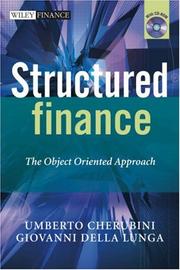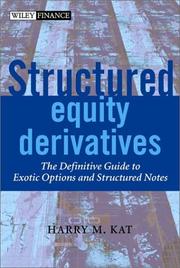| Listing 1 - 10 of 187 | << page >> |
Sort by
|

ISBN: 9789812566898 9812566899 Year: 2007 Publisher: New Jersey World scientific
Abstract | Keywords | Export | Availability | Bookmark
 Loading...
Loading...Choose an application
- Reference Manager
- EndNote
- RefWorks (Direct export to RefWorks)
Derivative securities --- Structured notes (Securities) --- Mathematical models

ISBN: 9780470026380 0470026383 Year: 2007 Publisher: Chichester: Wiley,
Abstract | Keywords | Export | Availability | Bookmark
 Loading...
Loading...Choose an application
- Reference Manager
- EndNote
- RefWorks (Direct export to RefWorks)
Structured notes (Securities) --- Derivative securities --- Investment analysis --- Financial engineering

ISBN: 9780750668552 0750668555 9780080461649 0080461646 1280642424 9781280642425 9786610642427 6610642427 Year: 2006 Publisher: Burlington, MA Butterworth-Heinemann
Abstract | Keywords | Export | Availability | Bookmark
 Loading...
Loading...Choose an application
- Reference Manager
- EndNote
- RefWorks (Direct export to RefWorks)
This book has two themes: Private Banking and investment decisions regarding Structural Financial Products. Dr. Dimitris Chorafas examines in a rigorous way whether structured financial products are advisable investments for retail and institutional investors and, if yes, which risks they entail. As our society becomes increasingly affluent, and state-supported pension schemes find it difficult to survive, a growing number of high net-worth individuals, and families, have become retail investors - looking for ways and means to optimize wealth management, and Private Banking deals with these so
Finance --- Structured notes (Securities) --- Private banks. --- Financial engineering.
Book
ISBN: 1118471113 111847113X 1119192188 Year: 2017 Publisher: Chichester, [England] : Wiley,
Abstract | Keywords | Export | Availability | Bookmark
 Loading...
Loading...Choose an application
- Reference Manager
- EndNote
- RefWorks (Direct export to RefWorks)
Foreign exchange options. --- Structured notes (Securities) --- Derivative securities.

ISBN: 0471486523 Year: 2002 Publisher: Chichester Wiley
Abstract | Keywords | Export | Availability | Bookmark
 Loading...
Loading...Choose an application
- Reference Manager
- EndNote
- RefWorks (Direct export to RefWorks)
Book
ISBN: 0123846838 012384682X 9780123846839 9780123846822 Year: 2014 Publisher: London, United Kingdom : Academic Press, an imprint of Elsevier,
Abstract | Keywords | Export | Availability | Bookmark
 Loading...
Loading...Choose an application
- Reference Manager
- EndNote
- RefWorks (Direct export to RefWorks)
Book
ISBN: 1108236049 1108596843 1108416209 Year: 2018 Publisher: Cambridge : Cambridge University Press,
Abstract | Keywords | Export | Availability | Bookmark
 Loading...
Loading...Choose an application
- Reference Manager
- EndNote
- RefWorks (Direct export to RefWorks)
This book provides a comprehensive but concise treatment of the subject of derivatives. It focuses on making essential concepts accessible to a wider audience. The book eschews complicated mathematics and high school level mathematics is sufficient to understand it. It describes and explains various derivative instruments, their use and pricing, and the functioning of derivative markets. It uses a large number of examples to elucidate concepts and illustrate their real-life application. A distinguishing feature of the book is that it goes beyond the narrow perspective of derivative traders and investors and takes a broader approach which enhances its appeal to a range of readers. This book will be useful for students in the fields of economics, econometrics, derivatives, and finance and financial professionals, bankers and investors.

ISBN: 9780470129852 Year: 2008 Publisher: Hoboken Wiley
Abstract | Keywords | Export | Availability | Bookmark
 Loading...
Loading...Choose an application
- Reference Manager
- EndNote
- RefWorks (Direct export to RefWorks)

ISBN: 0750668555 9786610642427 1280642424 0080461646 9780750668552 9780080461649 9781280642425 6610642427 Year: 2006 Publisher: Amsterdam Boston Elsevier/Butterworth-Heinemann
Abstract | Keywords | Export | Availability | Bookmark
 Loading...
Loading...Choose an application
- Reference Manager
- EndNote
- RefWorks (Direct export to RefWorks)
This book has two themes: Private Banking and investment decisions regarding Structural Financial Products. Dr. Dimitris Chorafas examines in a rigorous way whether structured financial products are advisable investments for retail and institutional investors and, if yes, which risks they entail. As our society becomes increasingly affluent, and state-supported pension schemes find it difficult to survive, a growing number of high net-worth individuals, and families, have become retail investors - looking for ways and means to optimize wealth management, and Private Banking deals with these so
Structured notes (Securities) --- Private banks. --- Financial engineering. --- Computational finance --- Engineering, Financial --- Structured securities --- Finance --- Banks and banking --- Fixed-income securities --- Derivative securities
Book
ISBN: 9781119109419 Year: 2015 Publisher: Chichester Wiley
Abstract | Keywords | Export | Availability | Bookmark
 Loading...
Loading...Choose an application
- Reference Manager
- EndNote
- RefWorks (Direct export to RefWorks)
"A detailed, expert-driven guide to today's major financial point of interest The xVA Challenge: Counterparty Credit Risk, Funding, Collateral, and Capital is a practical guide from one of the leading and most influential credit practitioners, Jon Gregory. Focusing on practical methods, this informative guide includes discussion around the latest regulatory requirements, market practice, and academic thinking. Beginning with a look at the emergence of counterparty risk during the recent global financial crisis, the discussion delves into the quantification of firm-wide credit exposure and risk mitigation methods, such as netting and collateral. It also discusses thoroughly the xVA terms, notably CVA, DVA, FVA, ColVA, and KVA and their interactions and overlaps. The discussion of other aspects such as wrong-way risks, hedging, stress testing, and xVA management within a financial institution are covered. The extensive coverage and detailed treatment of what has become an urgent topic ^makes this book an invaluable reference for any practitioner, policy maker, or student. Counterparty credit risk and related aspects such as funding, collateral, and capital have become key issues in recent years, now generally characterized by the term 'xVA'. This book provides practical, in-depth guidance toward all aspects of xVA management. Market practice around counterparty credit risk and credit and debit value adjustment (CVA and DVA) The latest regulatory developments including Basel III capital requirements, central clearing, and mandatory collateral requirements The impact of accounting requirements such as IFRS 13 Recent thinking on the applications of funding, collateral, and capital adjustments (FVA, ColVA and KVA) The sudden realization of extensive counterparty risks has severely compromised the health of global financial markets. It's now a major point of action for all financial institutions, which have realized the growing importance of consistent treatmen t of collateral, funding, and capital alongside counterparty risk. The xVA Challenge: Counterparty Credit Risk, Funding, Collateral, and Capital provides expert perspective and real-world guidance for today's institutions"-- "This book explains the emergence of counterparty risk during the recent credit crisis. The quantification of firm-wide credit exposure for trading desks and businesses is discussed alongside risk mitigation methods such as netting and collateral management (margining) and central counterparties. Banks and other financial institutions have been recently developing their capabilities for pricing counterparty risk and these elements are considered in detail via a characterisation of credit value adjustment (CVA). The implications of an institution valuing their own default via debt value adjustment (DVA) and funding costs (FVA) are also considered at length. Portfolio management and hedging of CVA are described in full. Wrong--way counterparty risks are addressed in detail in relation to interest rate, foreign exchange, commodity and credit derivative products. Regulatory capital for counterparty risk, including the recent Basel III requirements for CVA VAR is discussed. The management of counterparty risk within an institution by a "CVA desk" is also discussed in detail. Finally, the design and benefits of central clearing, a recent development to attempt to control the rapid growth of counterparty risk, is considered. Hedging aspects, together with the associated instruments such as credit defaults swaps (CDSs) and contingent CDS (CCDS) are described in full. This book is unique in being practically focused but also covering the more technical aspects. It is an invaluable complete reference guide for any market practitioner, policy maker, academic or student with any responsibility or interest within the area of counterparty credit risk and CVA"--
Derivative securities --- -Derivative financial instruments --- Derivative financial products --- Derivative instruments --- Derivatives (Finance) --- Financial derivatives --- Securities --- Structured notes (Securities) --- Mathematical models --- Risk management. --- Mathematical models. --- -Mathematical models
| Listing 1 - 10 of 187 | << page >> |
Sort by
|

 Search
Search Feedback
Feedback About UniCat
About UniCat  Help
Help News
News